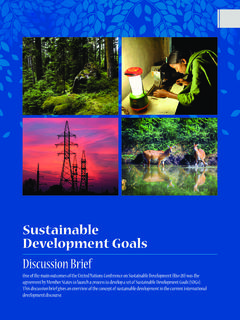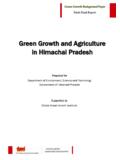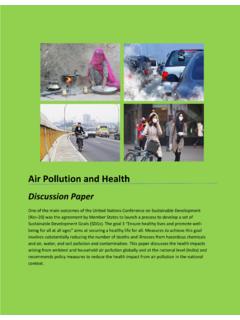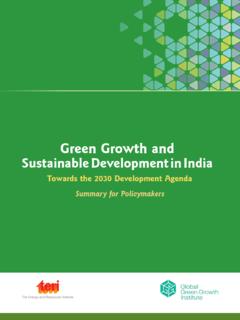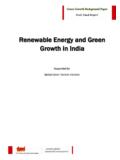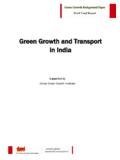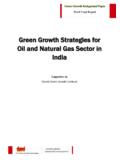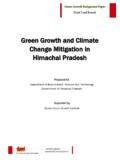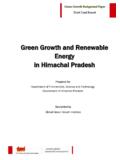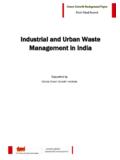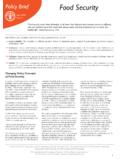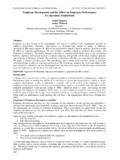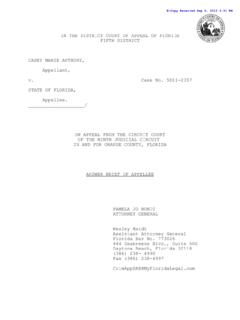Transcription of POLICY BRIEF TERI Policy Brief F - The Energy and ...
1 TERI POLICY BRIEFThe Energy and Resources InstituteThe Energy and Resources InstituteDarbari Seth Block, IHC Complex,Lodhi Road, New Delhi- 110 003 Tel. 2468 2100 or 4150 4900 Fax. 2468 2144 or 2468 2145 India +91 Delhi (0) 11 Biofuel Promotion in India for Transport: Exploring the Grey AreasAuthorsDr Kaushik Ranjan Bandyopadhyay, Associate Professor, TERI UniversityReviewer Dr Saon Roy, Senior Fellow, ICRIER Introduction 1 Policies and Initiatives for Biofuels in India: An Assessment 2 Environmental and Social Sustainability of Biofuel Promotion in India 5 Concluding Remarks 8 References 9 FEBRUARY 2015 IntroductionIndia happens to be the world s fourth largest Energy consumer and a consumer of crude and petroleum products after the United States, China, and The net oil import dependency of India rose from 43 per cent in 1990 to 71 per cent in 20122 that resulted in a huge strain on the current account as well as the government exchequer.
2 Transport sector accounts for the largest share (around 51 per cent) in terms of consumption of petroleum products in India. Nearly 70 per cent of diesel and per cent petroleum are consumed by the transport sector3 and the demand is expected to grow at 6 8 per cent over the coming years in tandem with the rapidly expanding vehicle ownership. Evidently, India s Energy security would remain vulnerable until alternative fuels based on indigenously produced renewable feedstock are developed to substitute or supplement petro-based fuels (Government of India, 2008). A number of alternative Energy options coupled with various initiatives towards Energy efficiency improvement and Energy conservation are being promoted in India to deal with an impending crisis. Among the portfolio of renewable Energy alternatives that are available, biofuels, especially ethanol and biodiesel (refer to Box 1 for taxonomy), have emerged as a preferred option, especially for the transport sector in India.
3 The objective is to reduce dependence on imported crude oil in order to enhance the country s Energy security. The other reasons behind promotion of biofuels in India include climate change mitigation through reduced greenhouse gas (GHG) emission, environmentally sustainable development, and generation of new employment opportunities (Government of India, 2008).1 (last accessed on October 22, 2014)2 (last accessed on October 22, 2014)3 (last accessed on October 22, 2014)TERI POLICY BriefTERI POLICY Brief2 ISSUE 16 FEBRUARY 2015 BOX 1: TAXONOMY OF BIOFUELSB iofuel is a generic term that refers to fuel derived from biomass, such as plants and organic wastes. The International Energy Agency (IEA) adopts a simplified classification of biofuels based on the maturity of the technology deployed. This taxonomy uses terms like conventional and advanced to distinguish between different types of biofuels.
4 *Conventional biofuels, , the first generation biofuels, include sugar- and starch-based ethanol, oil-crop based biodiesel and straight vegetable oil, as well as biogas derived through anaerobic digestion. The technology for conventional biofuel is well-established and is being deployed for producing biofuels on a commercial scale. The most common conventional biofuels that are largely used as transport fuels are ethanol and biodiesel. Both ethanol and biodiesel are used in internal combustion engines either in its pure form or more often as an additive. Advanced biofuels, , the second- or third-generation biofuels, include biofuels based on feedstock like lignocellulosic biomass, which include cellulosic ethanol, biomass-to-liquids diesel, and bio-synthetic gas. The category also includes novel conversion technologies, such as algae-based biofuels and the conversion of sugar into diesel-type biofuels using biological or chemical catalysts, and biofuel produced from conversion of agricultural residues.
5 The technologies deployed for producing advanced biofuels are still in the research and development (R&D) or demonstration stage. Note: *IEA, industry is yet to fully mature in India and it is difficult for the industry to sustain without subsidies, fuel mandates, or other government support. As biofuels are usually regarded as cleaner and greener alternatives to fossil fuels, the design of the subsidies and other POLICY supports to the sector is also generally done by keeping the potential positive benefits in view. However, recent scholarly studies based on Life Cycle Analysis (LCA), have cast serious doubts on the potential positive spill overs of biofuels on the environment. A number of studies have also found biofuels to be a major cause of worldwide food price inflation attributable primarily to the integration of oil and Energy markets with markets for agricultural commodities.
6 These studies have cautioned that biofuels could exacerbate food insecurity, lead to water shortages, aggravate water pollution, increase GHG emissions through land-use changes, and add to other indirect environmental costs, adversely affect biodiversity, and so on. Serious doubts have also been raised on the parameter of net Energy consumption of biofuels, , whether biofuels consume more Energy than they actually produce. Some recent LCA studies carried out in India have only reinforced this uncertainty with respect to net Energy consumption, GHG emission, and other environmental impacts of biofuels. Against this backdrop, the POLICY BRIEF makes an attempt to provide a more realistic assessment of the pros and cons of the promotion of biofuels in India, especially in light of the interests expressed by the new government to go ahead with more aggressive promotion of biofuels.
7 The structure of the POLICY BRIEF is as follows: It provides an assessment of biofuel initiatives and policies in India in retrospect and infers on whether the policies have actually been effective to reduce India s dependence on imported crude oil. It assesses the ability of biofuels in enhancing the environmental benignity and social sustainability of biofuels in India. The paper concludes with a set of POLICY and Initiatives for Biofuels in India: An Assessment Back in September 2002, the Ministry of Petroleum & Natural Gas (MoPNG), Government of India came up with a notification making 5 per cent blending of ethanol with petrol by the oil marketing companies (OMCs) mandatory in nine Indian states and four union territories with effect from January 2003, through its ambitious Ethanol Blending Programme (EBP).
8 A Committee on Development of Biofuels was also constituted in July 2002 by the Planning Commission and the final report was released in July 2003. The report recommended India to progressively move towards the use of biofuels. With regard to ethanol, the report called for further strengthening of the ongoing EBP. In India, ethanol is predominantly produced from sugarcane molasses a by-product of sugar production. Ethanol production in India, therefore, depends largely on the availability of sugar molasses, which in turn depends on the production of sugarcane. Since sugarcane production in India is cyclical, ethanol production also keeps fluctuating from one year to another, often failing to meet the optimum supply level required to meet the demand at any given point in time. Lower availability of sugarcane molasses and consequent higher molasses prices also affect the cost of production of ethanol, thereby disrupting its supply under EBP.
9 Thus, the January 2003 target of 5 per cent blending could be implemented only partially due to unavailability of ethanol, owing to low sugarcane production in the financial years 2003 04 and 2004 05. Resurgence in sugarcane production in 2005 06 and 2006 07 led the government to revive the TERI POLICY BriefTERI POLICY Brief3 ISSUE 16 FEBRUARY 20155 per cent blending norm in November 2006, mandating it for 20 states and four Union Territories, subject to commercial viability. In October 2007, the government announced a mandatory 5 per cent blending of ethanol with petrol across the country (except the Northeast, Jammu and Kashmir, and island territories). Even as the attainment of this 5 per cent blending target continued to remain elusive, owing to shortage in sugarcane supply in 2007 08, in October 2008, the government went ahead in pushing the bar upwards to 10 per cent, which however, never materialized.
10 In fact, the 5 per cent blending target has yet to be accomplished successfully. In order to augment availability of ethanol, since October 2007, the sugar industry has been permitted to produce ethanol directly from sugarcane juice. Even then adequate supply of ethanol for the EBP has continued to remain unaccomplished from time to time for a host of other reasons as well. While lack of availability of sugar molasses is a major constraint in this respect, there are other teething problems as well. Failures to set an ethanol pricing formula and procedural delays by various state governments are some of the reasons that are responsible for delayed procurement under the EBP, even in the years when there is good sugarcane production. As per the Ministry of Petroleum & Natural Gas (MoPNG) notification (Gazette Notification 4(E), dated ),4 oil marketing companies (OMCs) shall sell ethanol-blended petrol which has up to 10 per cent ethanol and as per the Bureau of Indian Standard (BIS) specification, 5 per cent ethanol blending has to be achieved across the country as a Although the benchmark price of ethanol had been fixed at `44 per litre and the government had made it mandatory for OMCs to blend 5 per cent ethanol with petrol, actual lifting remained unsatisfactory.
